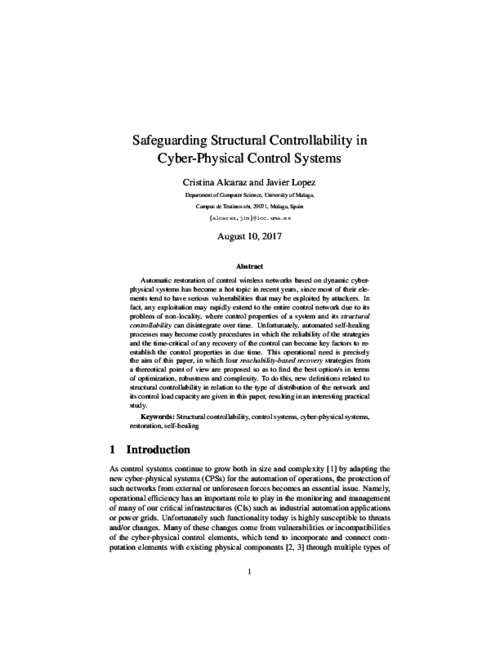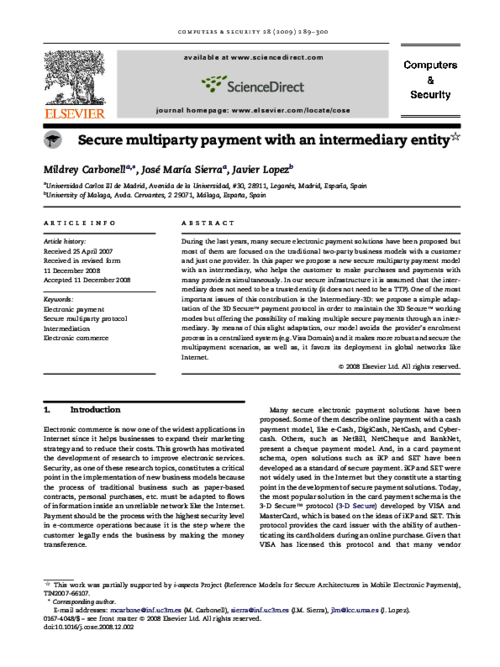 ] Type Year
] Type Year Journal of Network and Computer Applications, vol. 34, Elsevier, pp. 1168-1183, 2011.
Abstract
Grid computing has arisen as an evolution of distributed systems mainly focused on the sharing of and remote access to resources in a uniform, transparent, secure, efficient and reliable manner. It is possible to join Grid technology and mobile technology in order to create one of the most promising technologies and developments to appear in recent years, in that they enrich one another and provide new solutions that solve many of the limitations and problems found in different technologies. Security is a very important factor in Mobile Grid Computing and is also difficult to achieve owing to the open nature of wireless networks and heterogeneous and distributed environments. Success in obtaining a secure system originates in incorporating security from the first stages of the development process. It has therefore been necessary to define a development process for this kind of systems in which security is incorporated in all stages of the development and the features and particularities of the Mobile Grid systems are taken into consideration. This paper presents one of the activities of this development process, the design activity, which consists of defining and designing a security software architecture. This architecture will be built from a security architecture, defined as reference architecture, in which security services, interfaces and operations are defined with the purpose of defining a reference security architecture which covers the majority of security requirements identified in the analysis activity. The design activity will build the system architecture that will be the input artefact for the subsequent activity in the process, which is the construction activity.
21st International Information Security Conference (IFIP SEC’06), no. 201, Springer, pp. 221-232, May, 2006.
Abstract
Contract signing is a fundamental service in doing business. The Internet has facilitated the electronic commerce, and it is necessary to find appropriate mechanisms for contract signing in the digital world. A number of two-party contract signing protocols have been proposed with various features. Nevertheless, in some applications, a contract may need to be signed by multiple parties. Less research has been done on multi-party contract signing. In this paper, we propose a new synchronous multi-party contract signing protocol that, with n parties, it reaches a lower bound of 3(n − 1) steps in the all-honest case and 4n − 2 steps in the worst case (i.e., all parties contact the trusted third party). This is so far the most efficient synchronous multi-party contract signing protocol in terms of the number of messages required. We further consider the additional features like timeliness and abuse-freeness in the improved version.
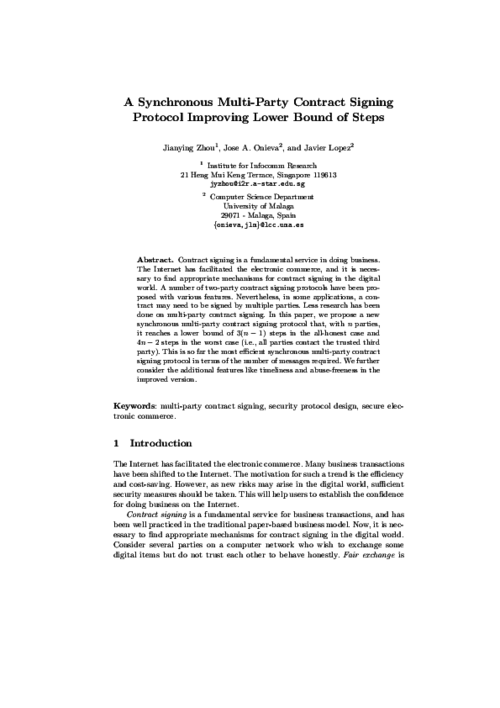
Computers & Security, Elsevier, pp. 103-180, 2023. DOI
Abstract
As the number of security and privacy attacks continue to grow around the world, there is an ever increasing need to protect our personal devices. As a matter of fact, more and more manufactures are relying on Trusted Execution Environments (TEEs) to shield their devices. In particular, ARM TrustZone (TZ) is being widely used in numerous embedded devices, especially smartphones, and this technology is the basis for secure solutions both in industry and academia. However, as shown in this paper, TEE is not bullet-proof and it has been successfully attacked numerous times and in very different ways. To raise awareness among potential stakeholders interested in this technology, this paper provides an extensive analysis and categorization of existing vulnerabilities in TEEs and highlights the design flaws that led to them. The presented vulnerabilities, which are not only extracted from existing literature but also from publicly available exploits and databases, are accompanied by some effective countermeasures to reduce the likelihood of new attacks. The paper ends with some appealing challenges and open issues.

3rd International Workshop on Security, Privacy and Trust in Pervasive and Ubiquitous Computing (SecPerU’07), IEEE Computer Society, pp. 25-30, 2007. DOI
Abstract
Trust plays an important role in human life environments and virtual organizations. In the context of a network, trust may help its elements to decide whether another member of the same network is being uncooperative or malicious. Trust becomes quite important in self-configurable and autonomous systems, such as wireless sensor networks (WSN). However, very little effort has been done in the field of trust management in WSN. On the other hand, some efforts have been made in quite related fields such as Ad-hoc and P2P networks. In this paper we give an overview of existing trust management solutions, mainly those developed for Ad-Hoc and P2P networks and, more importantly, investigate their suitability to WSN. We also provide some guidelines to aid the development of trust management systems for WSN according to the nature of these networks.
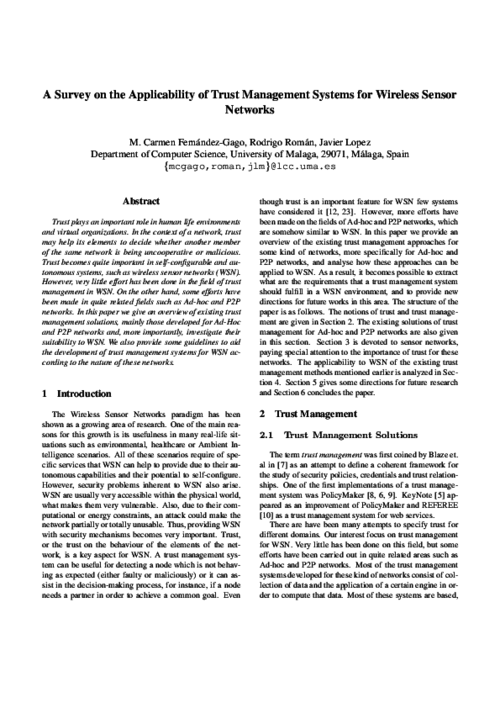
IEEE Communications Surveys and Tutorials, vol. 20, issue 4, IEEE, pp. 3453-3495, 07/2018. DOI
Abstract
As the deployment of Internet of Things (IoT) is experiencing an exponential growth, it is no surprise that many recent cyber attacks are IoT-enabled: The attacker initially exploits some vulnerable IoT technology as a first step towards compromising a critical system that is connected, in some way, with the IoT. For some sectors, like industry, smart grids, transportation and medical services, the significance of such attacks is obvious, since IoT technologies are part of critical backend systems. However, in sectors where IoT is usually at the enduser side, like smart homes, such attacks can be underestimated, since not all possible attack paths are examined. In this paper we survey IoT-enabled cyber attacks, found in all application domains since 2010. For each sector, we emphasize on the latest, verified IoT-enabled attacks, based on known real-world incidents and published proof-of-concept attacks. We methodologically analyze representative attacks that demonstrate direct, indirect and subliminal attack paths against critical targets. Our goal is threefold: (i) To assess IoT-enabled cyber attacks in a risk-like approach, in order to demonstrate their current threat landscape; (ii) To identify hidden and subliminal IoT-enabled attack paths against critical infrastructures and services, and (iii) To examine mitigation strategies for all application domains.
Mobile Networks and Applications, vol. 12, no. 4, Springer, pp. 231-244, August, 2007. DOI
Abstract
In a wireless sensor network environment, a sensor node is extremely constrained in terms of hardware due to factors such as maximizing lifetime and minimizing physical size and overall cost. Nevertheless, these nodes must be able to run cryptographic operations based on primitives such as hash functions, symmetric encryption and public key cryptography in order to allow the creation of secure services. Our objective in this paper is to survey how the existing research-based and commercial-based sensor nodes are suitable for this purpose, analyzing how the hardware can influence the provision of the primitives and how software implementations tackles the task of implementing instances of those primitives. As a result, it will be possible to evaluate the influence of provision of security in the protocols and applications/scenarios where sensors can be used.
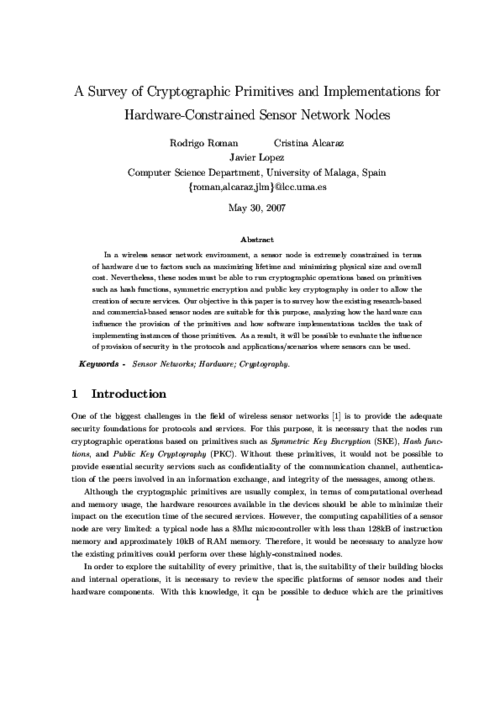
IV International Information Security Conference (ISC’01), LNCS 2200, Springer-Verlag, pp. 46-62, October, 2001.
Abstract
We present the adaptation of our model for the validation ofkey distribution and authentication protocols to address speci c needsof protocols for electronic commerce. The two models defer in both thethreat scenario and in the formalization. We demonstrate the suitabilityof our adaptation by analyzing a speci c version of the Internet BillingServer protocol introduced by Carnegie Mellon University. Our analysisshows that, while the security properties a key distribution or authenticationprotocol shall provide are well understood, it is often not clearwhat properties an electronic commerce protocol can or shall provide.Our methods rely on automatic theorem proving tools. Speci cally, weused Øtter", an automatic theorem proving software developed at ArgonneNational Laboratories.
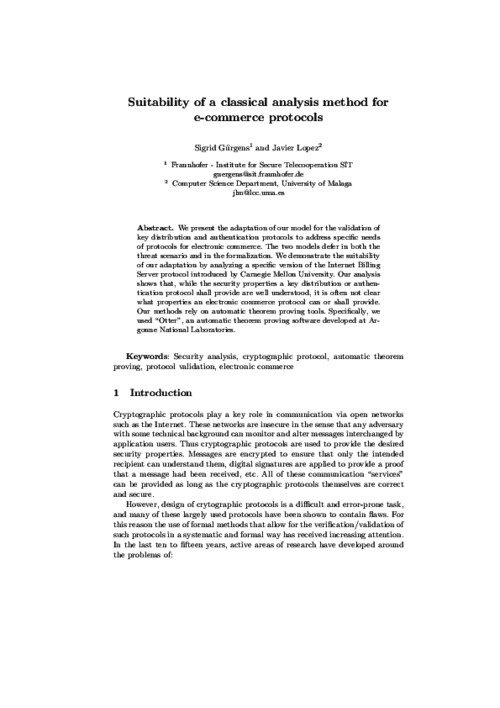
5th International Conference on Software and Data Technologies (ICSOFT’10), vol. 1, Springer, pp. 133-138, july, 2010.
Abstract
Mobile Grid systems allow us to build highly complex information systems with various and remarkable features (interoperability between multiple security domains, cross-domain authentication and authorization, dynamic, heterogeneous and limited mobile devices, etc), which demand secure development methodologies to build quality software, offering methods, techniques and tools that facilitate the work of the entire team involved in software development. These methodologies should be supported by Grid security architectures that define the main security aspects to be considered, and by solutions to the problem of how to integrate mobile devices within Grid systems. Some approaches regarding secure development methodologies of Grid security architectures and of the integration of mobile devices in the Grid have been found in literature, and these are analyzed and studied in this paper, offering a comparison framework of all the approaches related to security in Mobile Grid environments.
Journal of Information Security and Applications, vol. 61, no. 102916, Elsevier, 09/2021. DOI
Telematics and Informatics, vol. 23, no. 3, Elsevier, pp. 179-195, 2006.
Abstract
In this paper we have defined an open framework to support open distributed applications where anonymous transactions based on user privileges play an important role. The goal of the framework is to provide a basis to the application level, and is presented from an open and general perspective where many different implementation schemes can fit. Moreover, we have presented a set of requirements that implementation schemes must fulfill to conform a fully anonymous privilege system, which guarantees to supported applications that anonymity will be preserved in remote transactions. Finally, we present an application scenario using the services provided by the framework in order to better show the possibilities of what this type of systems offers.
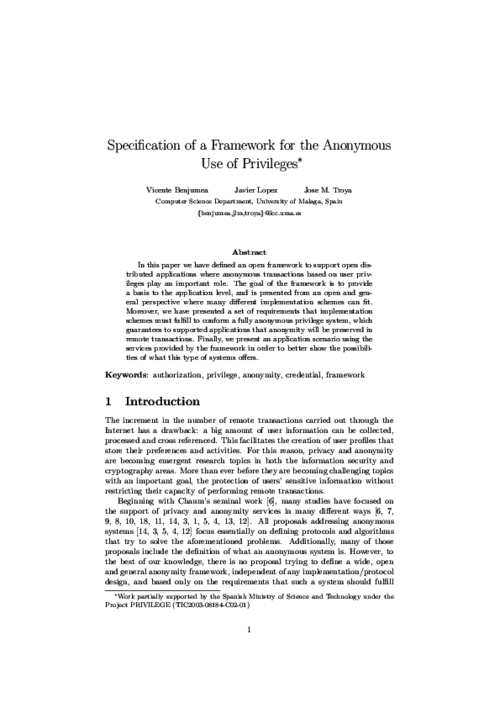
5th international conference on Computer systems and technologies (CompSysTech ’04), ACM, pp. 1-6, 2004. DOI
Abstract
With the grown of internet and distributed applications, security requirements are going inherent to the software development process. Each time one communicates with some other one there are relevant security risk that must be taken in account. This is what is happening in the new soft-ware applications using client/server architecture. We propose including security requirements at the top level of development process, together with functional requirements because they are much related. With this information we are able to extract all communication protocols that are involved in our application and their associated security goals. This is the input to a verification phase in which we look for security flaws. The last step, and the more useful (and the not yet finished) is to use this information to modify our initial specification at the top level of the development process
Computer Standards & Interfaces, vol. 27, no. 5, Elsevier, pp. 467-478, Jun 2005. DOI
Abstract
A challenging task in security engineering concerns the specification and integration of security with other requirements at the top level of requirements engineering. Empirical studies show that it is common at the business process level that customers and end users are able to express their security needs. Among the security needs of Internet applications, authentication and authorization services are outstanding and, sometimes, privacy becomes a parallel requirement. In this paper, we introduce a methodology for the specification of security requirements and use a case study to apply our solution. We further detail the resulting system after extending it with an Authentication and Authorization Infrastructure.
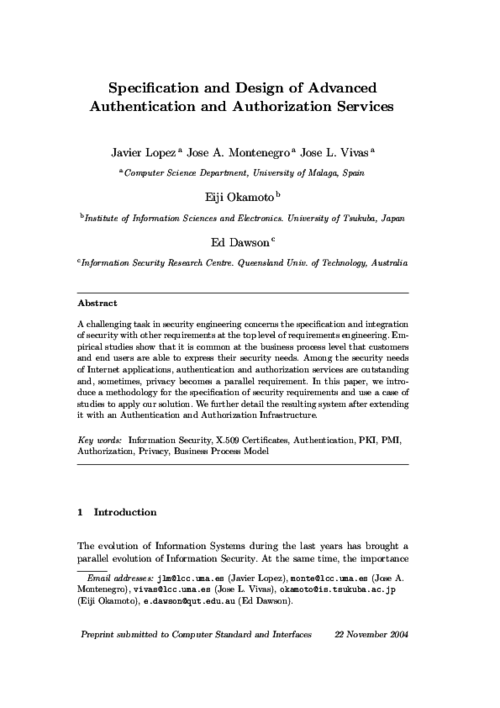
4th International Symposium of Ubiquitous Computing and Ambient Intelligence (UCAmI’10), L. Fuentes, N. Gámez, and J. Bravo Eds., IBERGARCETA PUBLICACIONES, S.L., pp. 29 - 38, Sept., 2010.
Abstract
Wireless Sensor Networks are considered to be one of the cornerstones of Ambient Intelligence since they can be used in countless applications, where sensors are unobtrusively embedded into the environment to perform operations like monitoring, tracking and reporting. In such scenarios, privacy issues must be carefully considered since the mere observation of the network operation might reveal great amounts of private information to unauthorised parties. One of the problems that is gaining more attention in the realm of privacy, is the location privacy problem, which aims to prevent an attacker from obtaining the location of specific nodes of interest to him. In this paper we provide a general overview of the proposed solutions to counter this threat. Finally, we will also discuss some open challenges and future directions of research for a convenient management of privacy issues in smart environments.

Computers & Security, vol. 38, Elsevier, pp. 14-27, OCT 2013. DOI
Abstract
Any deliberate or unsuitable operational action in control tasks of critical infrastructures, such as energy generation, transmission and distribution systems that comprise sub-domains of a Smart Grid, could have a significant impact on the digital economy: without energy, the digital economy cannot live. In addition, the vast majority of these types of critical systems are configured in isolated locations where their control depends on the ability of a few, supposedly trustworthy, human operators. However, this assumption of reliabilty is not always true. Malicious human operators (criminal insiders) might take advantage of these situations to intentionally manipulate the critical nature of the underlying infrastructure. These criminal actions could be not attending to emergency events, inadequately responding to incidents or trying to alter the normal behaviour of the system with malicious actions. For this reason, in this paper we propose a smart response mechanism that controls human operators’ operational threats at all times. Moreover, the design of this mechanism allows the system to be able to not only evaluate by itself, the situation of a particular scenario but also to take control when areas are totally unprotected and/or isolated. The response mechanism, which is based on Industrial Wireless Sensor Networks (IWSNs) for the constant monitoring of observed critical infrastructures, on reputation for controlling human operators’ actions, and on the ISA100.11a standard for alarm management, has been implemented and simulated to evaluate its feasibility for critical contexts.
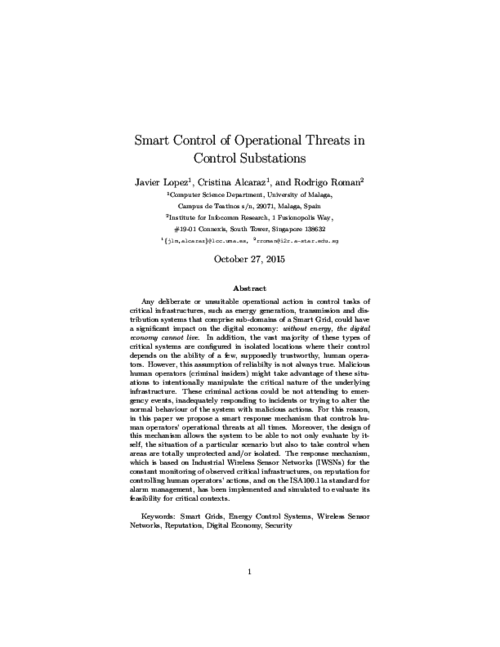
IEEE Communications Magazine, vol. 46, no. 4, IEEE, pp. 102-107, April, 2008. DOI
Abstract
A wireless sensor network should be able to operate for long periods of time with little or no external management. There is a requirement for this autonomy: the sensor nodes must be able to configure themselves in the presence of adverse situations. Therefore, the nodes should make use of situation awareness mechanisms to determine the existence of abnormal events in their surroundings. This work approaches the problem by considering the possible abnormal events as diseases, thus making it possible to diagnose them through their symptoms, namely, their side effects. Considering these awareness mechanisms as a foundation for high-level monitoring services, this article also shows how these mechanisms are included in the blueprint of an intrusion detection system.
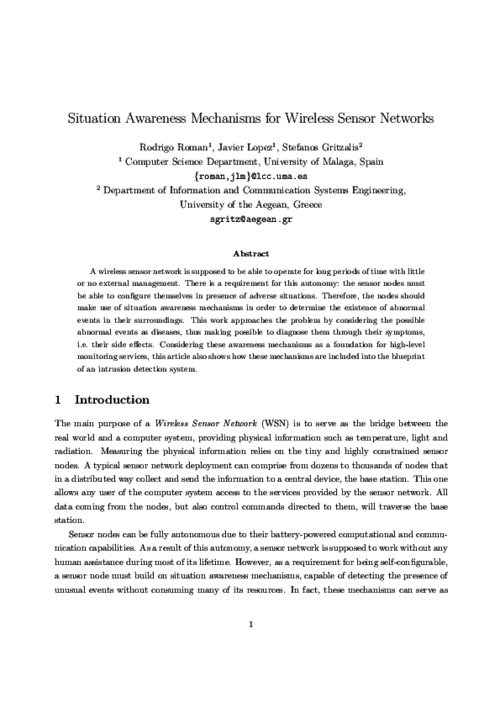
I Jornadas de Ingeniería Telemática (JITEL’97), pp. 295-302, Sep 1997.
III Reunión Española de Criptología (III REC), pp. 133-138, Noviembre, 1994.
Revista SIC: Seguridad en Informática y Comunicaciones, vol. 38, pp. 1-5, 2001.
Proceedings of the Doctoral Symposium of the International Symposium on Engineering Secure Software and Systems (ESSoS-DS 2012), J. Cuellar, and N. Koch Eds., CEUR-WS 834, CEUR-WS, pp. 41-46, 2012.
Abstract
As the Future Internet arrives, more complex, service-based applications are spreading. These applications pose several challenges, including the huge amount of entities that must interact and their het- erogeneity. The success of these applications depends on the collaboration and communication of these entities, that might belong to different or- ganizations and administrative domains. Therefore, trust and reputation become two crucial issues. We propose the specification and design of a service-based security architecture that stresses the delivery of trust and reputation services to any application that might require them.
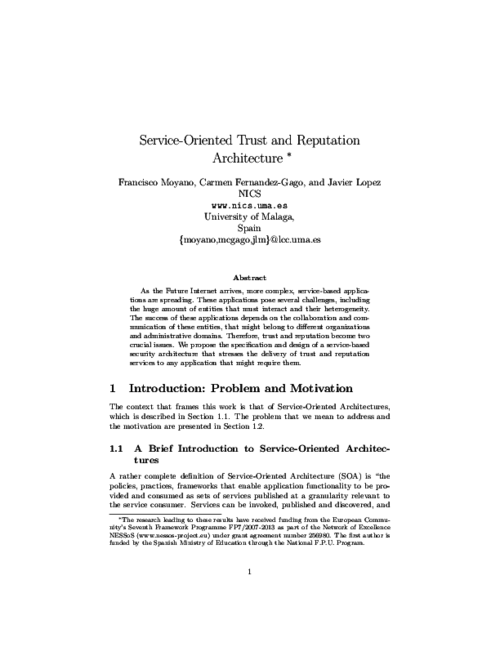
2nd International Workshop on Security Privacy and Trust in Pervasive and Ubiquitous Computing (SecPerU’06), IEEE Press, pp. 1-6, June, 2006.
Abstract
The extraordinary growth of the Information Society is originating a high dependency on ICT. This provokes that those strongly interrelated technological infrastructures, as well as the information systems that underpin them, become highly critical, since their disruption would lead to high economical, material and, sometimes, human loss. As a consequence, the protection of these Critical Information Infrastructures is becoming a major objective for governments and companies. In this paper, we give an overview of the main challenges and open research issues on Critical Information Infrastructure security, and introduce an on-going research project that, using wireless sensor networks as an underlying technology, is dealing with those problems. Our research project focuses on the development of protection, control, evaluation, maintenance and verification mechanisms, integrated into a secure service-oriented architecture.
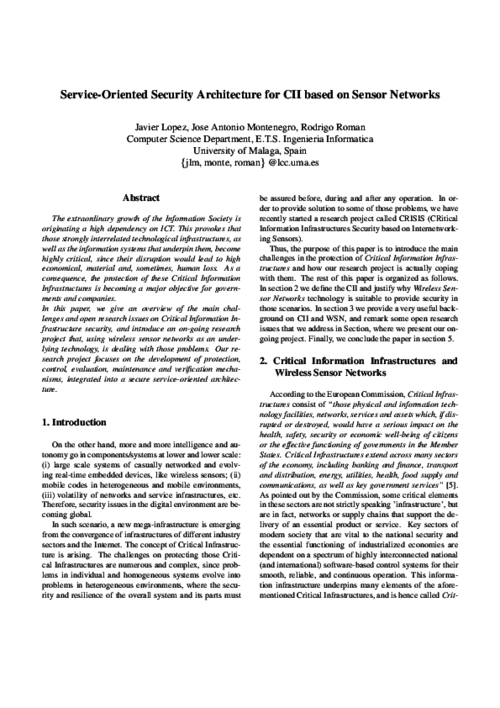
5th International Symposium on Security and Multimodality in Pervasive Environments (SMPE’11), IEEE, March, 2011. DOI
Abstract
Key Management Schemes (KMS) are a very important security mechanism for Wireless Sensor Networks (WSN), as they are used to manage the credentials (i.e. secret keys) that are needed by the security primitives. There is a large number of available KMS protocols in the literature, but it is not clear what should network designers do to choose the most suitable protocol for the needs of their applications. In this paper, we consider that given a certain set of application requirements, the network designer can check which properties comply with those requirements and select the KMS protocols that contains those particular properties. Therefore, we study the relationship between requirements and properties, and we provide a web tool, the SenseKey tool, that can be used to automatically obtain an optimal set of KMS protocols.
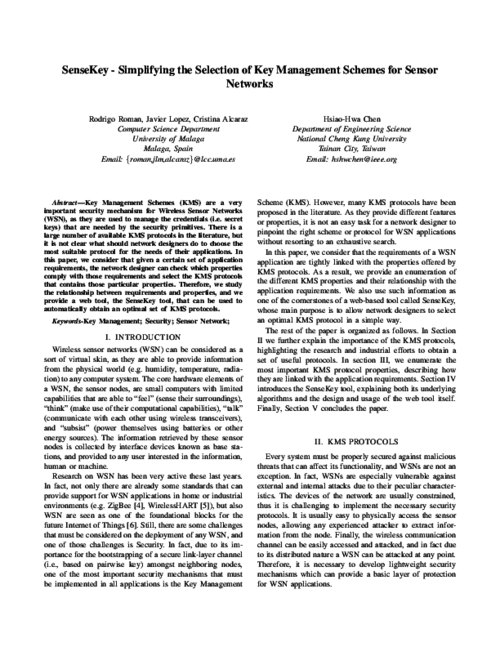
The 11th International Conference on Critical Information Infrastructures Security, vol. 10242, pp. 176-188, 2017.
Abstract
The introduction of the Smart Grid brings with it several benefits to society, because its bi-directional communication allows both users and utilities to have better control over energy usage. However, it also has some privacy issues with respect to the privacy of the customers when analysing their consumption data. In this paper we review the main privacy-preserving techniques that have been proposed and compare their efficiency, to accurately select the most appropriate ones for undertaking control operations. Both privacy and performance are essential for the rapid adoption of Smart Grid technologies.
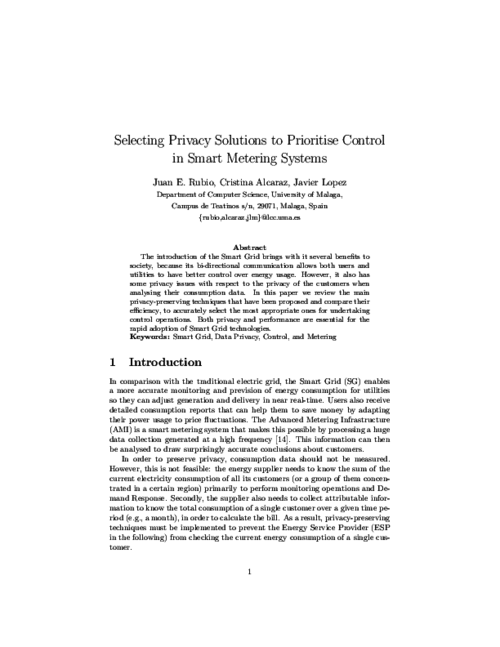
Computers & Security, vol. 31, no. 38, Elsevier, pp. 956–966, Nov 2012. DOI
Abstract
Key management in wireless sensor networks (WSN) is an active research topic. Due to the fact that a large number of key management schemes (KMS) have been proposed in the literature, it is not easy for a sensor network designer to know exactly which KMS best fits in a particular WSN application. In this article, we offer a comprehensive review on how the application requirements and the properties of various key management schemes influence each other. Based on this review, we show that the KMS plays a critical role in determining the security performance of a WSN network with given application requirements. We also develop a method that allows the network designers to select the most suitable KMS for a specific WSN network setting. In addition, the article also addresses the issues on the current state-of-the-art research on the KMS for homogeneous (i.e. non-hierarchical) networks to provide solutions for establishing link-layer keys in various WSN applications and scenarios.

X Symposium Nacional de la Unión Científica Internacional de Radio (URSI’95), pp. 147-150, Septiembre, 1995.
IEEE Consumer Communications & Networking Conference 2019, IEEE, 03/2019. DOI
Abstract
With the ever-increasing number of smart home devices, the issues related to these environments are also growing. With an ever-growing attack surface, there is no standard way to protect homes and their inhabitants from new threats. The inhabitants are rarely aware of the increased security threats that they are exposed to and how to manage them. To tackle this problem, we propose a solution based on segmented architectures similar to the ones used in industrial systems. In this approach, the smart home is segmented into various levels, which can broadly be categorised into an inner level and external level. The external level is protected by a firewall that checks the communication from/to the Internet to/from the external devices. The internal level is protected by an additional firewall that filters the information and the communications between the external and the internal devices. This segmentation guarantees a trusted environment between the entities belonging to the internal network. In this paper, we propose an adaptive trust model that checks the behaviour of the entities and, through this model, in case the entities violate trust rules they can be put in quarantine or banned from the network.
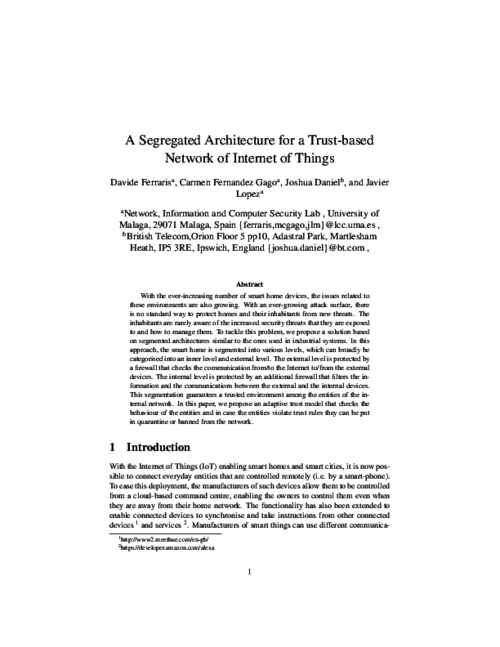
Journal of Systems Architecture, vol. 57, Elsevier, pp. 240-258, 2011.
Abstract
Mobile Grid, is a full inheritor of the Grid with the additional feature that it supports mobile users andresources. Security is an important aspect in Grid based systems, and it is more complex to ensure thisin a mobile platform owing to the limitations of resources in these devices. A Grid infrastructure that supportsthe participation of mobile nodes and incorporates security aspects will thus play a significant rolein the development of Grid computing. The idea of developing software through systematic developmentprocesses to improve software quality is not new. However, many information systems such as those ofGrid Computing are still not developed through methodologies which have been adapted to their mostdifferentiating features. The lack of adequate development methods for this kind of systems in whichsecurity is taken into account has encouraged us to build a methodology to develop them, offering adetailed guide for their analysis, design and implementation. It is important to use software V&V techniques,according to IEEE Std. 1012 for Software Verification and Validation, to ensure that a software systemmeets the operational needs of the user. This ensures that the requirements for the system arecorrect, complete, and consistent, and that the life-cycle products correctly design and implement systemrequirements. This paper shows part of a development process that we are elaborating for the constructionof information systems based on Grid Computing, which are highly dependent on mobile devices inwhich security plays a highly important role. In the design activity of the process, we design a securityarchitecture which serves as a reference for any mobile Grid application that we wish to build since thissecurity architecture defines a complete set of security services which will be instantiated depending onthe requirements and features found in previous activities of the process. A V&V task is also defined in thedesign activity to validate and verify both the architecture built and the traceability of the artifacts generatedin this activity. In this paper, we will present the service-oriented security architecture for MobileGrid Systems which considers all possible security services that may be required for any mobile Grid application.
Computer Standards & Interfaces, vol. 27, no. 3, Elsevier, pp. 489-499, 2005.
Abstract
Organizations need to develop formally analyzed systems in order to achieve well-known formal method benefits. In order to study the security of communication systems, we have developed a methodology for the application of the formal analysis techniques, commonly used in communication protocols, to the analysis of cryptographic protocols. In particular, we have extended the design and analysis phases with security properties. Our proposal uses a specification notation based on one of the most used standard requirement languages HMSC/MSC, which can be automatically translated into a generic SDL specification. The SDL system obtained can then be used for the analysis of the addressed security properties, by using an observer process schema. Besides our main goal to provide a notation for describing the formal specification of security systems, our proposal also brings additional benefits, such as the study of the possible attacks to the system, and the possibility of re-using the specifications produced to describe and analyse more complex systems.

Computational Science and Its Applications (ICCSA’05), LNCS 3482, Springer, pp. 681-690, May, 2005. DOI
Abstract
Wireless Sensor Networks are extremely vulnerable against any kind of internal or external attacks, due to several factors such as resource-constrained nodes and lack of tamper-resistant packages. As a result, security must be an important factor to have in mind when designing the infrastructure and protocols of sensor networks. In this paper we survey the state-of-the-art security issues in sensor networks and highlight the open areas of research.security issues in sensor networks and highlight the open areas of research.
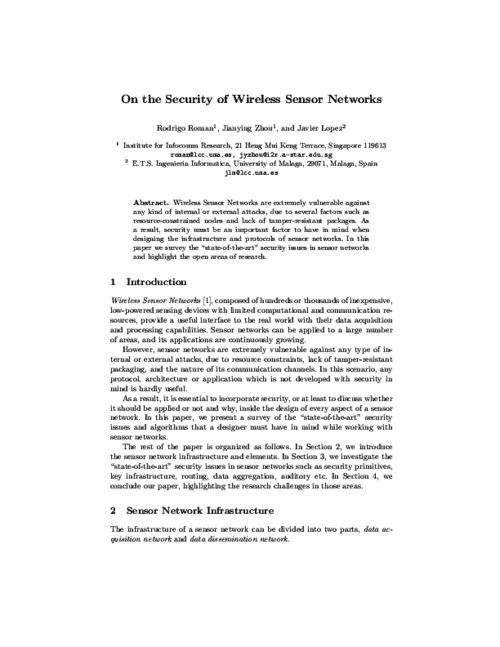
Ad Hoc Networks, vol. 11, Elsevier, pp. 1091–1104, 2013. DOI
Abstract
The main objective of remote substations is to provide the central system with sensitive information from critical infrastructures, such as generation, distribution or transmission power systems. Wireless sensor networks have been recently applied in this particular context due to their attractive services and inherent benefits, such as simplicity, reliability and cost savings. However, as the number of control and data acquisition systems that use the Internet infrastructure to connect to substations increases, it is necessary to consider what connectivity model the sensor infrastructure should follow: either completely isolated from the Internet or integrated with it as part of the Internet of Things paradigm. This paper therefore addresses this question by providing a thorough analysis of both security requirements and infrastructural requirements corresponding to all those TCP/IP integration strategies that can be applicable to networks with constrained computational resources.
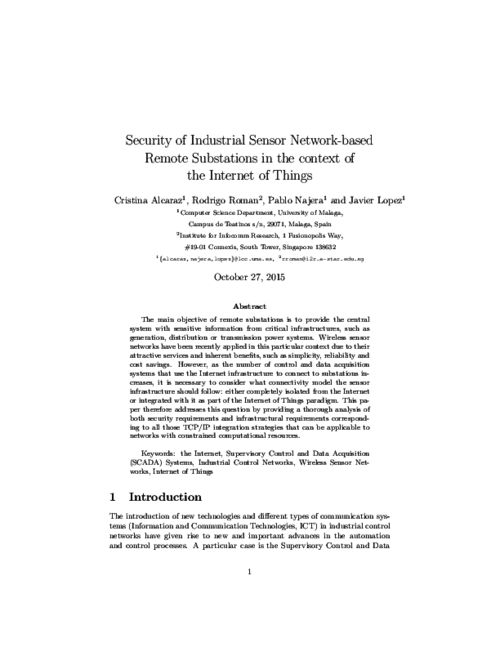
Journal of Universal Computer Science, vol. 15, pp. 970-991, 2009. DOI
Abstract
Traditional paper documents are not likely to disappear in the near future as they are present everywhere in daily life, however, paper-based documentation lacks the link with the digital world for agile and automated processing. At the same time it is prone to cloning, alteration and counterfeiting attacks. E-passport defined by ICAO and implemented in 45 countries is the most relevant case of hybrid documentation (i.e. paper format with electronic capabilities) to date, but, as the advantages of hybrid documentation are recognized more and more will undoubtedly appear. In this paper, we present the concept and security requirements of general-use e-documents, analyze the most comprehensive security solution (i.e. ePassport security mechanisms) and its suitability for general-purpose e-documentation. Finally, we propose alternatives for the weakest and less suitable protocol from ePassports: the BAC (Basic Access Control). In particular, an appropriate key management infrastructure for access control to document memory is discussed in conjunction with a prototype implementation.
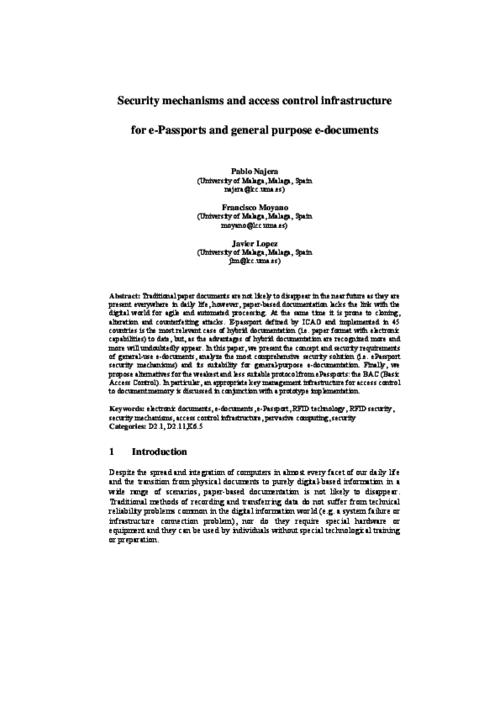
Advances in Grid Computing, Zoran Constantinescu, Intech, pp. 173-198, 2011.

Computer Standards and Interfaces, vol. 32, no. 5-6, Elsevier, pp. 230-245, Oct 2010. DOI
Abstract
This paper describes the security framework that is to be developed for the generic grid platform created for the project GREDIA. This platform is composed of several components that need to be secured. The platform uses the OGSA standards, so that the security framework will follow GSI, the portion of Globus that implements security. Thus, we will show the security features that GSI already provides and we will outline which others need to be created or enhanced.
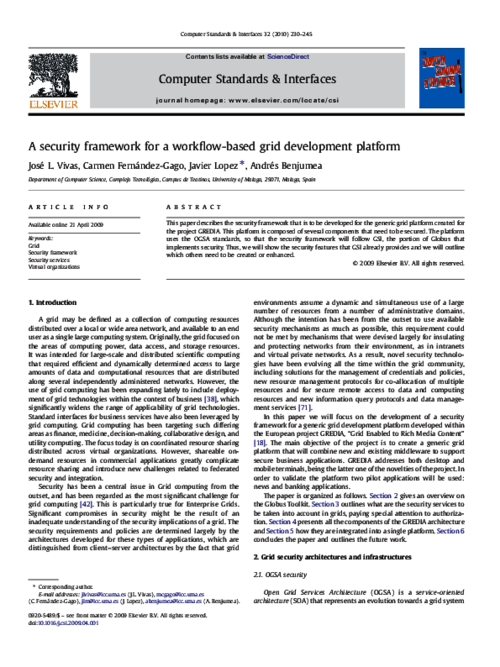
International Conference on Computer Systems and Technologies (CompSysTech09), ACM, pp. 11.7.1-11.7.6, 2009. DOI
Abstract
Assurance has been a major topic for critical systems. Assurance is usually associated with safety conditions but has also an important role for checking security requirements. Security is best assured if it is addressed holistically, systematically, and from the very beginning in the software’s development process. We propose to integrate assurance and system development by letting the different stages of the system development life-cycle be mapped to the structure of the assurance case.
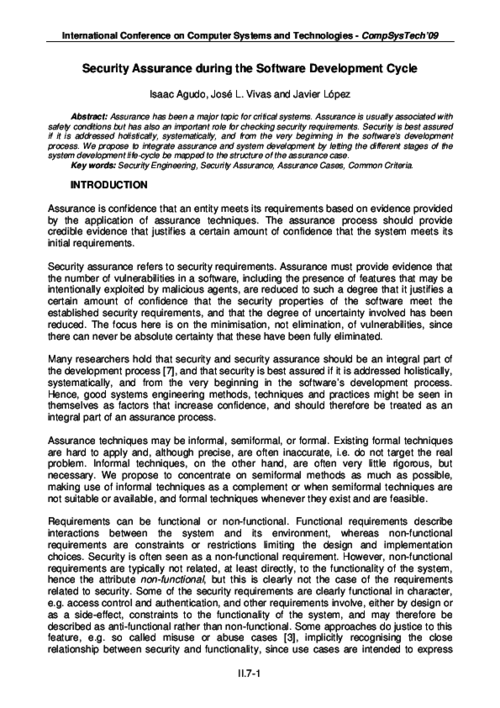
Critical Infrastructure Protection: Information Infrastructure Models, Analysis, and Defense, J. Lopez, S.. Wolthunsen, and R. Setola Eds., Advances in Critical Infrastructure Protection: Information Infrastructure Models, Analysis, and Defense. LNCS 7130. 7130, Springer-Verlag, pp. 120-149, September 2012.
Abstract
SCADA Systems can be seen as a fundamental component in Critical Infrastructures, having an impact in the overall performance of other Critical Infrastructures interconnected. Currently, these systems include in their network designs different types of Information and Communication Technology systems (such as the Internet and wireless technologies), not only to modernize operational processes but also to ensure automation and real-time control. Nonetheless, the use of these new technologies will bring new security challenges, which will have a significant impact on both the business process and home users. Therefore, the main purpose of this Chapter is to address these issues and to analyze the interdependencies of Process Control Systems with ICT systems, to discuss some security aspects and to offer some possible solutions and recommendations.
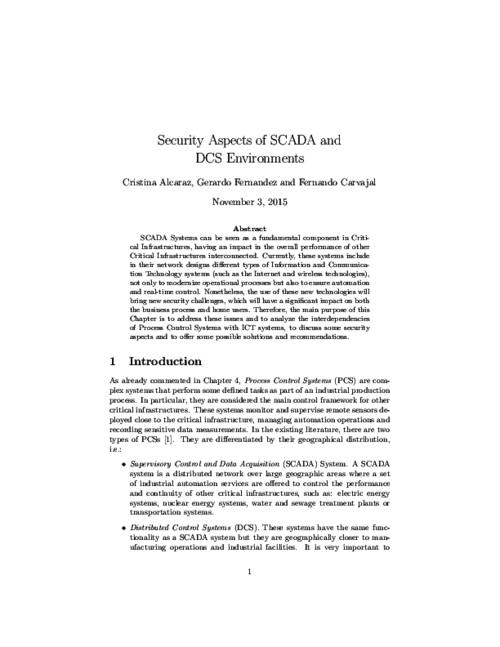
|
""Security and Trust Management"", 6th International Workshop, STM 2010, Athens, Greece, September 23-24, 2010. Proceedings, vol. 6710, 2010. 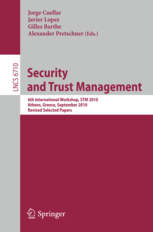 |  |
Advanced Information Networking and Applications Workshops (WAINA), 2012 26th International Conference on, IEEE, pp. 745-750, 03/2012. DOI
Abstract
Motivated by the growing convergence of diverse types of networks and the raise of new concepts such as Future Internet (FI), in this paper we present an analysis of current research on the development of security mechanisms in a tradeoff with Quality of Service (QoS) mechanisms. More precisely, we pay attention to the Security and QoS problems in resource-constrained networks that are candidates to be an important part of the FI due to their proximity to the user or because of their contribution to the information society. We analyse the current state of the research on security and QoS in the integration of sensors, MANET and cellular networks, with the aim of providing a critical point of view, allowing us to assess whether it is possible that such integration of networks is both secure and efficient.
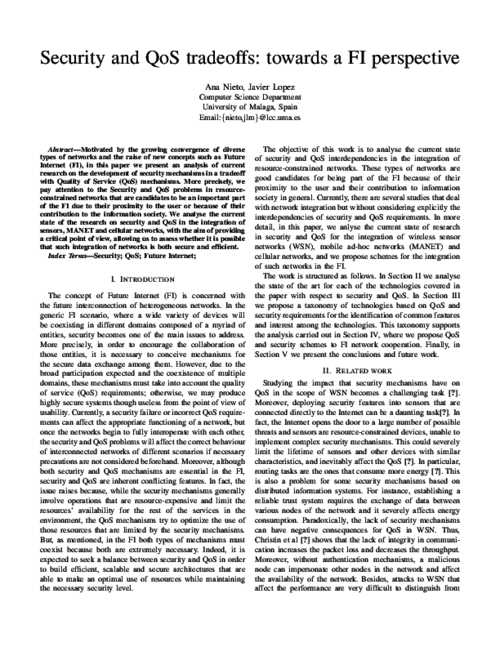
10th ACM International Symposium on QoS and Security for Wireless and Mobile Networks (Q2SWinet'14), ACM, pp. 25-32, 09/2014. DOI
Abstract
Context-based Parametric Relationship Models (CPRM) define complex dependencies between different types of parameters. In particular, Security and QoS relationships, that may occur at different levels of abstraction, are easily identified using CPRM. However, the growing number of parameters and relationships, typically due to the heterogeneous scenarios of future networks, increase the complexity of the final diagrams used in the analysis, and makes the current solution for assessing Security and QoS tradeoff (SQT) impractical for untrained users. In this paper, we define a recommendation system based on contextual parametric relationships in accordance with the definition of CPRM. The inputs for the system are generated dynamically based on the context provided by CPRM-based systems.
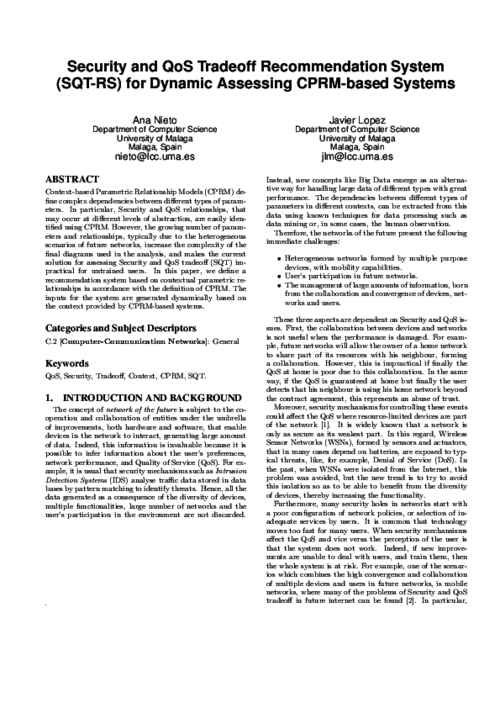
The 4th FTRA International Conference on Computer Science and its Applications (CSA 2012), Lecture Notes in Electrical Engineering 203, Springer Netherlands, pp. 13-21, 2012. DOI
Abstract
Mobile platforms are becoming a fundamental part of the user’s daily life. The human-device relationship converts the devices in a repository of personal data that may be stolen or modified by malicious users. Moreover, wireless capabilities open the door to several malicious devices, and mobility represents an added difficulty in the detection of malicious behavior and in the prevention of the same. Furthermore, smartphones are subject to quality of service (QoS) restrictions, due to the user needs for multimedia applications and, in general, the need to be always-on. However, Security and QoS requirements are largely confronted and the mobility and heterogeneous paradigm on the Future Internet makes its coexistence even more difficult, posing new challenges to overcome. We analyze the principal challenges related with Security and QoS tradeoffs in mobile platforms. As a result of our analysis we provide parametric relationships between security and QoS parameters focused on mobile platforms.
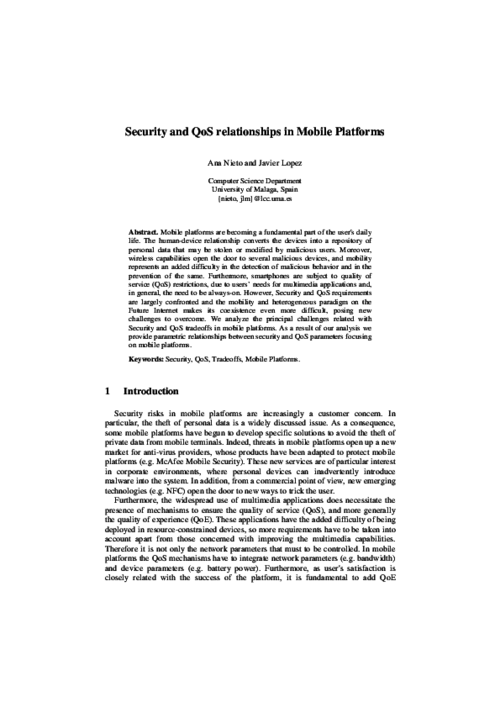
IEEE Transactions on Systems, Man, and Cybernetics, Part C: Applications and Reviews, vol. 40, no. 4, IEEE, pp. 419-428, July, 2010. DOI
Abstract
Nowadays, critical control systems are a fundamental component contributing to the overall performance of critical infrastructures in our society, most of which belong to the industrial sector. These complex systems include in their design different types of information and communication technology systems, such as wireless (mesh) sensor networks, to carry out control processes in real time. This fact has meant that several communication standards, such as Zigbee PRO, WirelessHART, and ISA100.11a, have been specified to ensure coexistence, reliability, and security in their communications. The main purpose of this paper has been to review these three standards and analyze their security. We have identified a set of threats and potential attacks in their routing protocols, and we consequently provide recommendations and countermeasures to help Industry protect its infrastructures.
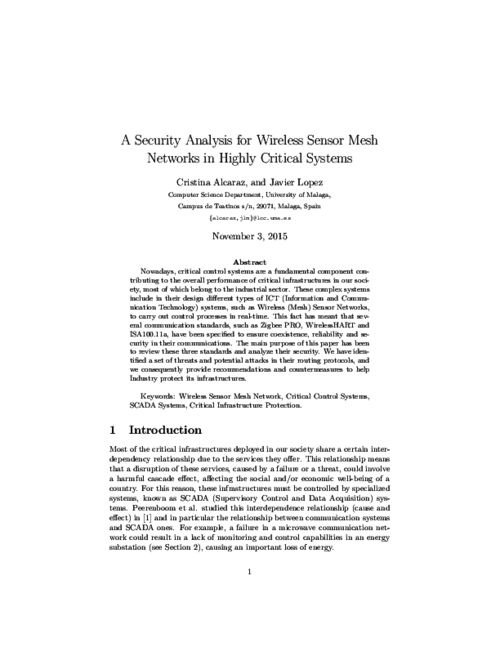
IEEE Computer, vol. 44, no. 9, IEEE, pp. 51 -58, Sept 2011. DOI
Abstract
This paper presents security of Internet of things. In the Internet of Things vision, every physical object has a virtual component that can produce and consume services Such extreme interconnection will bring unprecedented convenience and economy, but it will also require novel approaches to ensure its safe and ethical use. The Internet and its users are already under continual attack, and a growing economy-replete with business models that undermine the Internet’s ethical use-is fully focused on exploiting the current version’s foundational weaknesses.
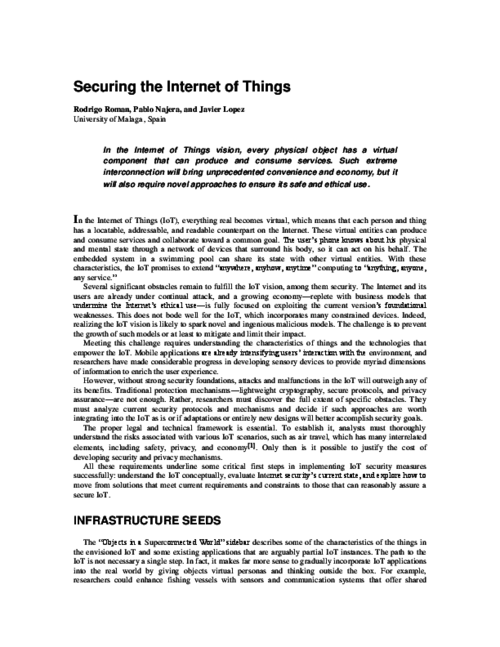
Securing Information and Communications Systems: Principles, Technologies and Applications
, Artech House, 2008.
 |  |
Online Information Review Journal, vol. 27, no. 3, Emerald, pp. 147-159, 2003.
Mathematical and Computer Modelling, vol. 57, Elsevier, pp. 2583–2595, Jun 2013. DOI
Abstract
This work describes the design and implementation of an auction system using secure multiparty computation techniques. Our aim is to produce a system that is practical under actual field constraints on computation, memory, and communication. The underlying protocol is privacy-preserving, that is, the winning bid is determined without information about the losing bids leaking to either the auctioneer or other bidders. Practical implementation of the protocol is feasible using circuit-based cryptographic proofs along with additively homomorphic bit commitment. Moreover, we propose the development of a Proof Certificatestandard. These certificates convey sufficient information to recreate the cryptographic proofs and verify them offline.
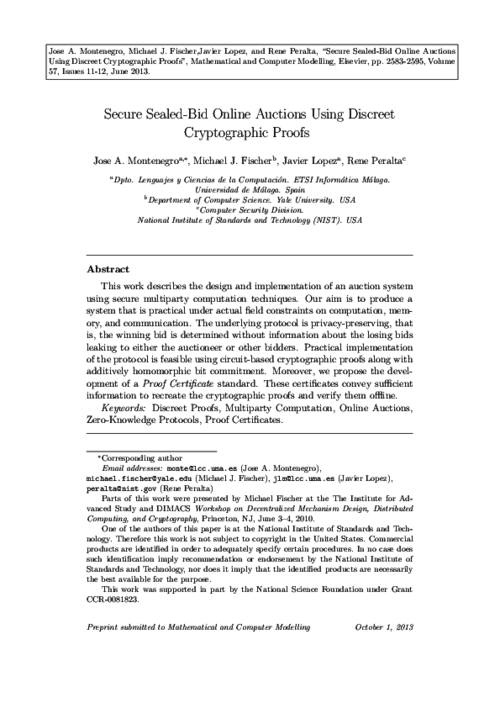
Concurrency and Computation Practice & Experience, vol. 23, no. 12, John Wiley & Sons, Inc., pp. 1414-1430, Aug 2011. DOI
Abstract
Energy distribution systems are becoming increasingly widespread in today’s society. One of the elements that is used to monitor and control these systems are the SCADA (Supervisory Control and Data Acquisition) systems. In particular, these control systems and their complexities, together with the emerging use of the Internet and wireless technologies, bring new challenges that must be carefully considered. Examples of such challenges are the particular bene¯ts of the integration of those new technologies, and also the e®ects they may have on the overall SCADA security. The main task of this paper is to provide a framework that shows how the integration of di®erent state-of-the-art technologies in an energy control system, such as Wireless Sensor Networks (WSNs), Mobile Ad-Hoc Networks (MANETs), and the Internet, can bring some interesting benefits such as status management and anomaly prevention, while maintaining the security of the whole system.
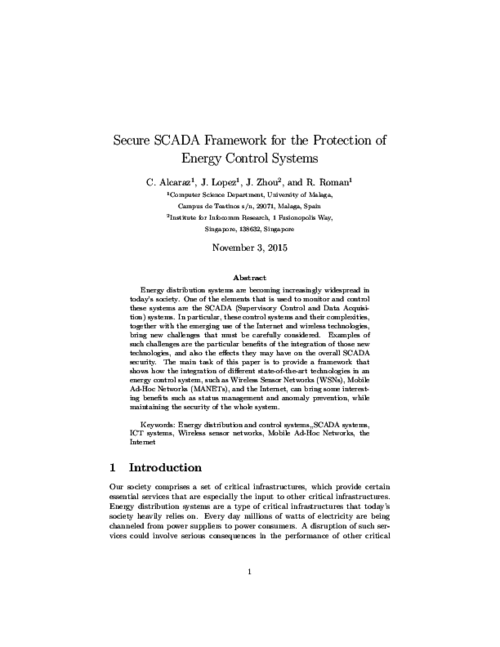
1st International Workshop on Secure Ubiquitous Networks (SUN’05), IEEE Press, pp. 214-218, August, 2005.
Abstract
Ubiquitous environments have several drawbacks to be solved. Most of them are focused on security, and relevant ones are authorization and authentication. Amongst the essential elements to adequately provide solutions, we can find profiles. A profile can be defined as a repository to store structured data from users, networks, devices, applications, etc. As profiles are needed in ubiquitous environments, and these need of secure management as well, in this paper, we provide some initial guidance on the security storage of profiles and on security levels needed for each type of profile. Additionally, we review different alternatives to bear profiles, concluding that smartcards are the most suitable devices.
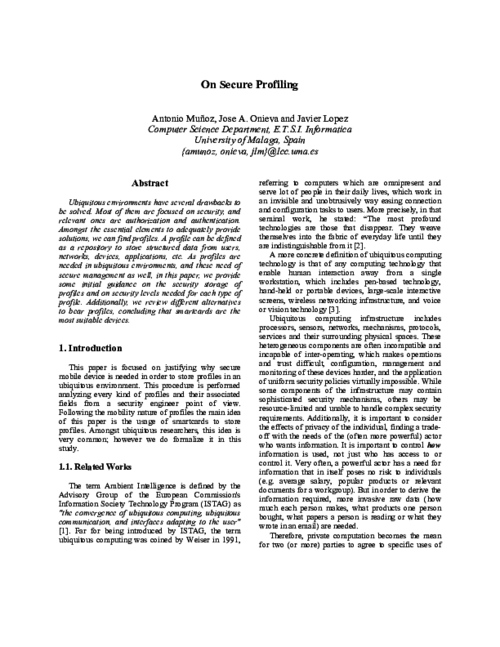
Computers and Security, vol. 28, no. 5, Elsevier, pp. 289-300, 2009.
|
"Secure Multi-Party Non-Repudiation Protocols and Applications", Advances in Information Security, vol. 43, Springer, 2009. 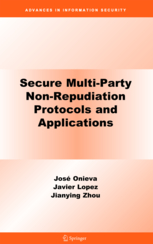 |  |
Novatica, New Trends in Network Management, vol. 9, no. 6, Cepis UPGRADE, pp. 22-28, December, 2008.
Abstract
When a Supervisory Control and Data Acquisition (SCADA) system monitors and manages other complex infrastructures through the use of distributed technologies, it becomes a critical infrastructure by itself: A failure or disruption in any of its components could implicate a serious impact on the performance of the other infrastructures. The connection with other systems makes a SCADA system more vulnerable against attacks, generating new security problems. As a result, it is essential to perform diverse security analysis frequently in order to keep an updated knowledge and to provide recommendations and/or solutions to mitigate or avoid anomalous events. This will facilitate the existence of a suitable, reliable, and available control network.
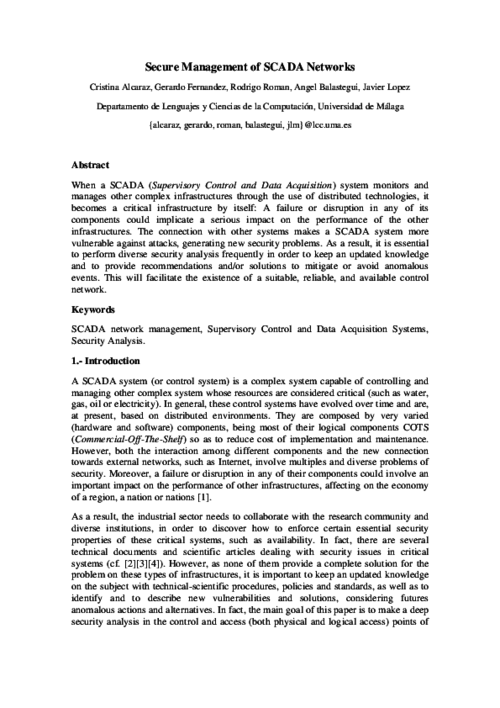
Security Solutions and Applied Cryptography in Smart Grid Communications, IGI Global, USA, IGI Global, pp. 137-158, 2017. DOI
Abstract
Transparency in control transactions under a secure network architecture is a key topic that must be discussed when aspects related to interconnection between heterogeneous cyber-physical systems (CPSs) arise. The interconnection of these systems can be addressed through an enforcement policy system responsible for managing access control according to the contextual conditions. However, this architecture is not always adequate to ensure a rapid interoperability in extreme crisis situations, and can require an interconnection strategy that permits the timely authorized access from anywhere at any time. To do this, a set of interconnection strategies through the Internet must be studied to explore the ability of control entities to connect to the remote CPSs and expedite their operations, taking into account the context conditions. This research constitutes the contribution of this chapter, where a set of control requirements and interoperability properties are identified to discern the most suitable interconnection strategies.
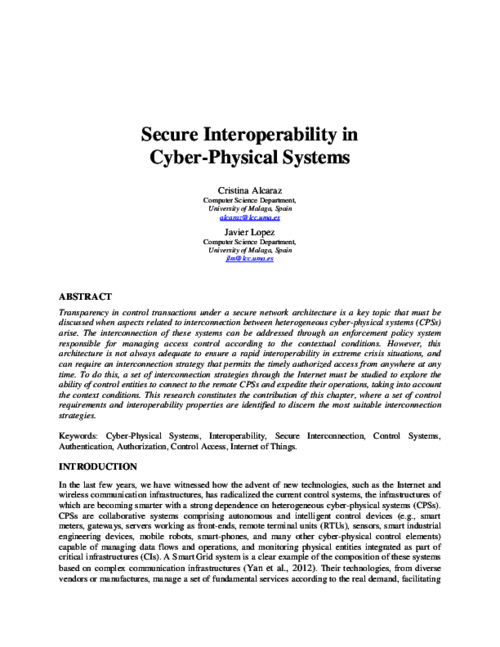
3rd Symposium of Ubiquitous Computing and Ambient Intelligence 2008, Advances in Soft Computing 51/2009, Springer, pp. 134-138, October, 2008. DOI
Abstract
Seamless human identification and authentication in the information system is a fundamental step towards the transparent interaction between the user and its context proposed in ambient intelligence. In this context, the IDENTICA project is aimed to the design and implementation of a distributed authentication platform based on biometrics (i.e. voice and facial image) and personal documentation. In this paper, we present our work in this project focused on the secure integration of RFID technology in personal documentation in order to provide seamless identity validation. Our actual work status, first results and future directions are described in detail.
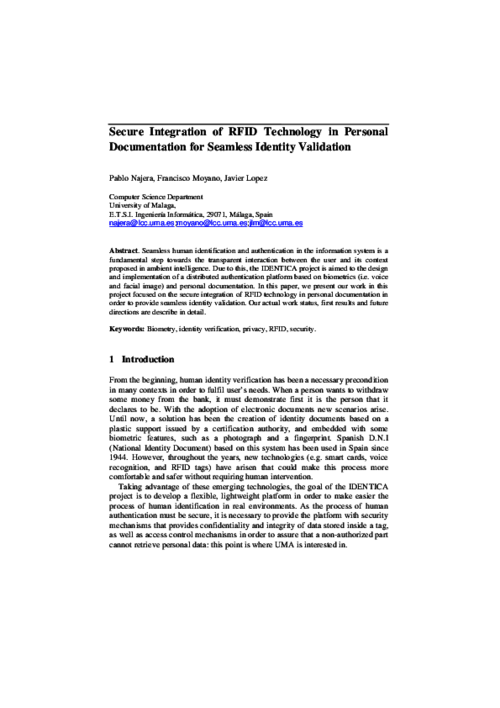
IFIP World Computer Congress, pp. 695-708, August, 1998.
Abstract
The objective of the present work is to present a solution to the problem of simultaneously examining groups of students in different computer laboratories while each student uses a computer with Internet access. The system presented focus on security and ease of use, being, at the same time, transparent to the users (students) and providing added services to the main objective of simultaneous examinations in several rooms with just one teacher.
7th International Workshop on Security and Trust Management (STM’11), LNCS 7170, Springer, pp. 207-222, 2012. DOI
Abstract
The secure integration of RFID technology into the personal network paradigm, as a context-aware technology which complements body sensor networks, would provide notable benefits to applications and potential services of the PN. RFID security as an independent technology is reaching an adequate maturity level thanks to research in recent years; however, its integration into the PN model, interaction with other network resources, remote users and service providers requires a specific security analysis and a PN architecture prepared to support these resource-constrained pervasive technologies. This paper provides such PN architecture and analysis. Aspects such as the management of personal tags as members of the PN, the authentication and secure communication of PN nodes and remote users with the context-aware technologies, and the enforcement of security and privacy policies are discussed in the architecture.

Third International Conference on Ubiquitous Intelligence and Computing, LNCS 4159, no. 4159, Springer, pp. 977-987, August, 2006.
Abstract
The increased heterogeneity and dynamism of new computing paradigms and especially of ubiquitous computing models is boosting the need for auto-configurable systems. In these new scenarios, heterogeneity and dynamism are inherent properties and applications are built by aggregating distributed information and services that are not under the control of a single entity. Furthermore, the current trend towards distributed computing poses important problems related to the need to transmit large amounts of data between the distributed nodes of the computing system; the control over the information; and the flexibility to adapt to heterogeneous client requirements. These characteristics are difficult to manage by traditional computing models. For these reasons, the mobile agent paradigm is gaining momentum and the interest of researchers and industry in this paradigm is increasing. In this paper we present a solution to provide a secure and auto-configurable environment for mobile agents in ubiquitous computing scenarios. Our approach is based on two main building blocks: trusted platforms and profiles.
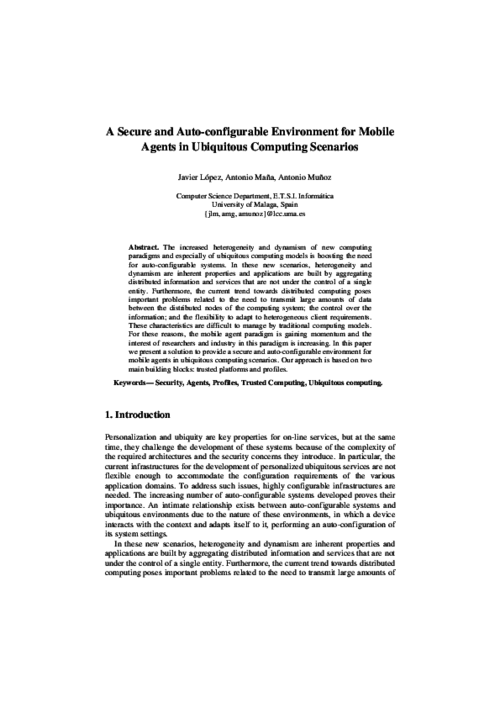
SCE’03, vol. 7, Fundacion Dintel, 2003.
14th International Conference on Critical Information Infrastructures Security (CRITIS 2019), vol. 11777, Springer, Cham, pp. 169-175, 12/2019. DOI
Abstract
In recent years, the Smart Grid has increasingly integrated cutting-edge technologies that generate several benefits for all the stakeholders involved, such as a more accurate billing system and enhanced Demand Response procedures. However, this modernization also brings with it diverse cyber security and privacy issues, which sets the necessity for developing a security platform specifically tailored to this scenario. In this paper, we present SealedGRID, which proposes a flexible architecture that provides security services at all levels by implementing Trusted Execution Environments on their devices, together with advanced authentication and authorization mechanisms, as well as privacy preserving techniques. These technologies are presented in depth and a final security analysis is conducted, which highlights the contributions of this project.
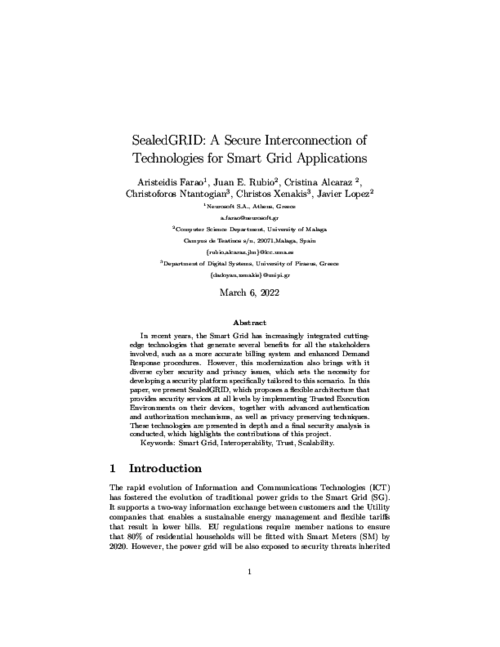
Computers and Mathematics with Applications, vol. 60, Elsevier, pp. 209-216, July, 2010. DOI
Abstract
When interactions among users of a system have to take place, for example, over the internet, establishing trust relationships among these users becomes crucial. However, the way this trust is established depends to a certain extent on the context where the interactions take place. Most of the time, trust is encoded as a numerical value that might not be very meaningful for a not very experienced user. In this paper we propose a model that takes into account the semantic and the computational sides of trust. This avoids users having to deal directly with the computational side; they instead deal with meaningful labels such as Bad or Good in a given context.
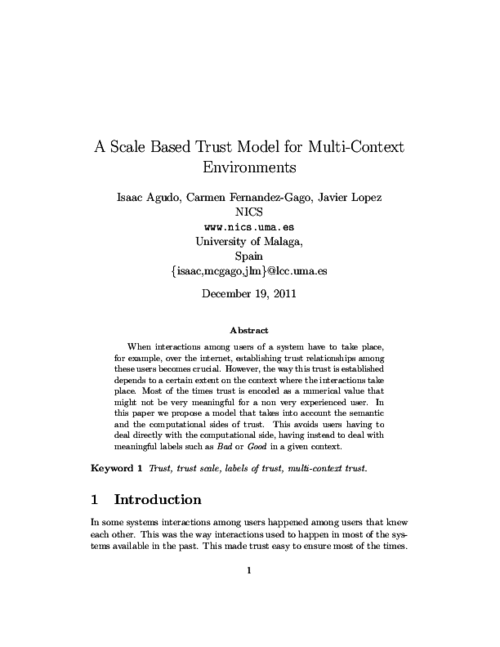
The 21st European Symposium on Research in Computer Security (ESORICS 2016), vol. 9879, Springer, pp. 471-489, 2016.
Abstract
Automatic restoration of control wireless networks based on dynamic cyber-physical systems has become a hot topic in recent years, since most of their elements tend to have serious vulnerabilities that may be exploited by attackers. In fact, any exploitation may rapidly extend to the entire control network due to its problem of non-locality, where control properties of a system and its structural controllability can disintegrate over time. Unfortunately, automated self-healing processes may become costly procedures in which the reliability of the strategies and the time-critical of any recovery of the control can become key factors to re-establish the control properties in due time. This operational need is precisely the aim of this paper, in which four reachability-based recovery strategies from a thereotical point of view are proposed so as to find the best option/s in terms of optimization, robustness and complexity. To do this, new definitions related to structural controllability in relation to the type of distribution of the network and its control load capacity are given in this paper, resulting in an interesting practical study.
